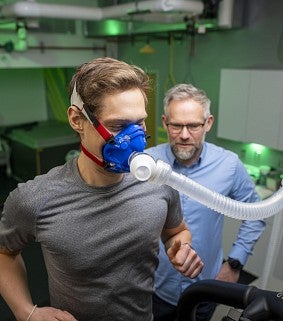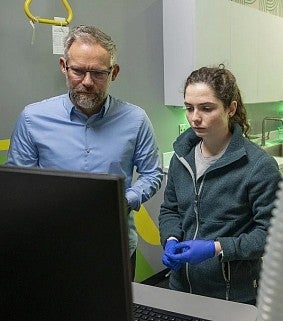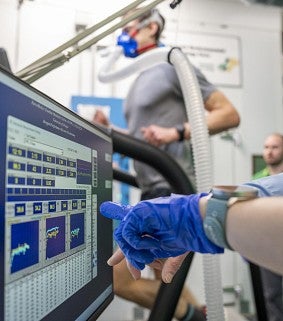
Experiential Learning | Research & Innovation | Community Impact | Career Preparation | Teaching Excellence | 21st Century Liberal Arts | Building Community | Good Vibes | CAS Spotlights | All Stories | Past Issues
Oregon Performance Research Lab
February 28, 2024
Pushing Human Limits
Working with some of the world’s top marathon runners sparked a burning question for Brad Wilkins, assistant professor of human physiology in the College of Arts and Sciences.
What keeps them from running faster?

A former high school pole vaulter himself, Wilkins has combined his passion for sports and his fascination with science into a unique career exploring the limits of human capability. After earning his PhD from the University of Oregon in 2003, Wilkins went on to work in the Nike+ Sport Research Laboratory, where he and his team attempted to help elite runners break the 2-hour marathon barrier—a feat that resulted in the National Geographic documentary Breaking2 in 2017.
For years, Wilkins straddled the line between industry and academia, teaching as an adjunct instructor for the UO Sport Product Management Program while working at Nike and then running his own human performance consulting business. That combination of industry experience and scientific expertise has led to his latest role as director of the new Oregon Performance Research Laboratory, whose goal is to put science into action by helping athletes reach beyond their perceived physical limits.
“I have an innate, deep curiosity about human interaction with the world at our limits,” Wilkins says. “I don’t have much interest in biological beings under resting conditions. My interest lies in what happens when we’re under stress, at our limits, at our highest levels. What is it that either keeps us going or stops us from going farther?”
In a lab equipped with treadmills, stationary bikes, metabolic analyzers, blood analysis equipment and an environmental simulation chamber, Wilkins and his research team are on a mission to propel athletic performance to new heights.
How did you become interested in studying human performance?
I grew up in a sports family. My father was a well-known high school basketball coach, and I was a three-sport athlete all through my childhood.
I wasn’t what you would call a great student because I focused a lot on sports, but I was always good at science. I remember specifically as an undergrad thinking about how I could marry those two things—sports and my love for scientific exploration. I started to find those areas of exercise science that were emerging from physical education departments at the time.

I developed a passion for understanding the limits of human potential, asking, ‘What, physiologically, really limits us during these sporting activities?’
What inspired you to start pushing the limits of human capability?
I think it’s human nature. It's always been part of our collective DNA as humans to pursue limits. Why did we go to the moon? Why climb Everest? Why explore the depths of the oceans? We have a collective curiosity as humans to explore the world around us, and some of us like to understand that point where we find our limits.
What’s interesting is that every time we hit those limits as humans, we are able to then build a tool or create a strategy to help us go farther. This is why I believe humans do not have any limits.
How did you get involved in the 'Breaking2' documentary?
I was in charge of the physiology research being done at Nike, working with some of their elite runners. And I have always been really interested in applying mathematical models or understanding mathematical predictions of human performance.
It was that mathematical modeling that led to us being able to convince the folks at Nike of the potential for a two-hour marathon. Our team had the math that said a 2-hour could be possible.
It started as a grassroots effort, with a few scientists really trying to push this idea. Once it started happening, it just kept snowballing.
What was the outcome of the project?
Marathon runner Eliud Kipchoge got really, really close to breaking it. He ran a marathon in two hours and 25 seconds, which was faster than anybody, at that time, by a couple of minutes. We felt really good about it.
A couple years after that, Kipchoge ended up breaking the two-hour marathon barrier the second time he tried, although neither of these attempts were a world record-sanctioned event.
What impact has 'Breaking2' had on the athletic world?
If you look at sanctioned marathons, the times that have been run since Breaking2 have come down abruptly. At the elite level, everybody has been getting faster at a much higher rate since Breaking2 than before.
In my mind, we helped pave the path for those who run marathons to believe they can run faster. I believe these leaps forward in human performance wouldn’t have happened unless we were pursuing some of these ideas around what humans are capable of doing.
What did you learn from the experience?
I learned that most of the barriers in front of us are not real. That was a big lesson—that barriers are often perceived and can be removed just by asking why they’re there.
It’s a lesson I apply in my own work by pursuing things that nobody has ever tried before, going after big questions nobody has ever asked before. These are ideas our lab here at UO will hopefully be all about.
What questions will the Oregon Performance Research Laboratory focus on?
One of the biggest research directions I want to pursue is understanding female athletes and how female sex hormones impact performance outcomes—especially endurance performance outcomes—compared to their male counterparts. One of the first studies we have funded looks at sex hormones across the menstrual cycle to see how these hormones might impact performance outcomes.

There’s a lot of information that has, at least, anecdotal backing from coaches' and trainers' observations of female athletes. But not a lot of it has been scientifically derived. Looking at hormone levels across the entire menstrual cycle, for example—that study hasn't been done in a controlled way to associate hormone levels with performance outcomes.
Another question we're asking is how the gut microbiome might interact with its human host to increase or modulate performance outcomes. We know the gut microbiome is important for brain health and cardiovascular health. We're asking questions around how these microbes that reside in the gut might be interacting with the way our muscles produce energy to help us perform at a high level.
How will your findings help athletes at UO and beyond?
We want to interact with athletes in our community and at the university who can help translate some of this information into action.
We want to be able to tell athletes, ‘Here's the best time to adapt to the stresses you're putting on your body, and here's the best time to take more recovery time.’ Or ‘Here's the time when you may be at your peak.’ We want to be able to take this research and tell female athletes, ‘Here's how your hormones impact your training at different times of the month,’ so they can plan accordingly based on what they know is physiologically happening.
A lot of athletes are being given this information, in my opinion, without scientific evidence. This is the potential impact of just one of our studies on athletes, and we are just getting started.
What is the ultimate goal of your lab?
Our mission is to discern physiological limits to measurably elevate human performance—to help people become measurably faster and stronger, to go farther and to jump higher. It is also my goal to train and develop curious and creative scientific thinkers who are pursuing these questions out in the world.
—Nicole Krueger, BA ’99 (journalism), is a communications coordinator for the College of Arts and Sciences.
